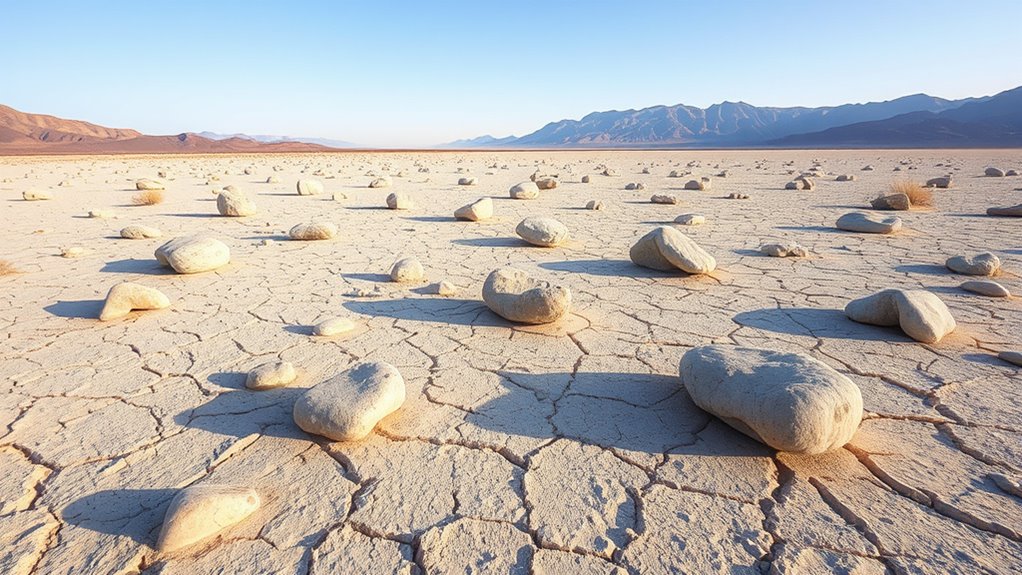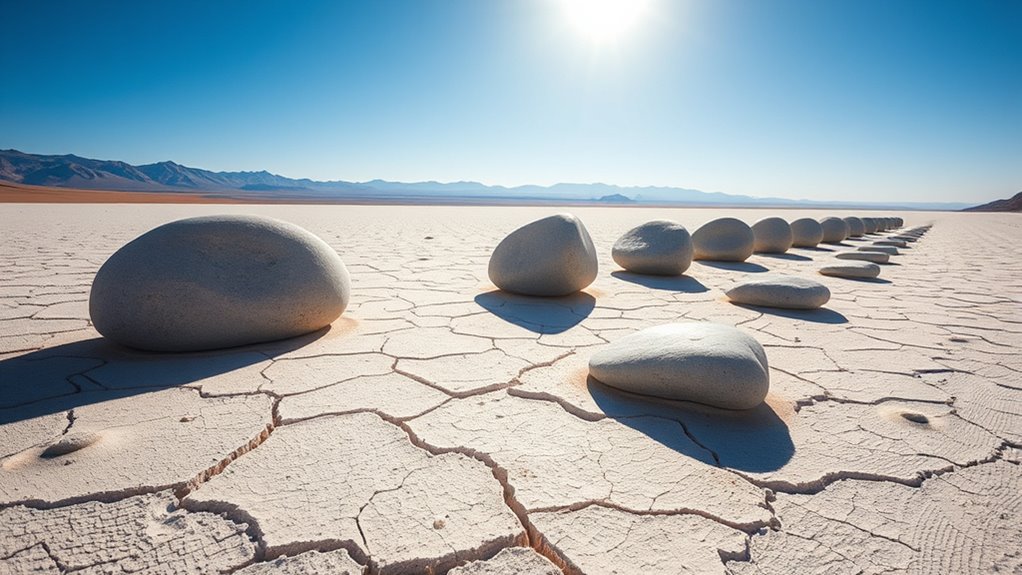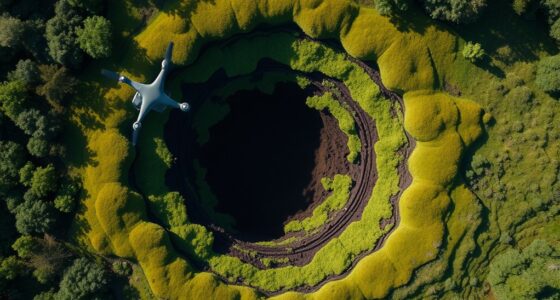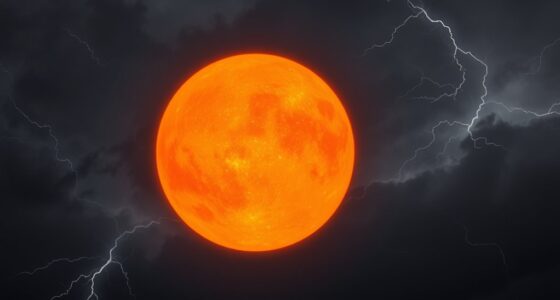You might wonder how stones seem to move on their own across Death Valley’s flats. The secret lies in a natural process where seasonal ice sheets form, then melt, creating a slippery layer that reduces friction. Wind and gentle slopes help the stones glide slowly, leaving trails behind. This fascinating phenomenon results from the unique geology and climate working together over thousands of years. Keep exploring to uncover the full story behind these mysterious moving rocks.
Key Takeaways
- Sailing stones move slowly across flat, dry clay pans due to ice sheets forming and melting during temperature fluctuations.
- The phenomenon is caused by a combination of thin ice layers, water lubrication, and light winds.
- The flatness of the playas allows stones to glide unobstructed, enabling their gradual movement.
- Cold weather creates ice sheets that lift and shift stones, leaving long, winding trails behind.
- The process results from natural geological and climate interactions, not magic or human intervention.

In the vast, arid landscape of Death Valley, a mysterious phenomenon known as the sailing stones captivates visitors and scientists alike. These stones seem to move across the desert floor on their own, leaving long, winding trails behind them. To understand this incredible natural event, you need to consider the geological formations that make up the valley floor and the climate patterns that influence their behavior. The landscape consists of flat, smooth clay pans called playas, which are incredibly sensitive to environmental changes. These geological formations are shaped over millennia by sediment deposits, erosion, and the shifting of the valley’s landscape. When you examine these formations, you can see how their structure creates the perfect stage for the sailing stones’ movement, especially when combined with specific climate patterns.
The climate in Death Valley plays a vital role in this phenomenon. The area experiences extreme temperature fluctuations, from scorching highs exceeding 120°F in the summer to cold nights that dip below freezing during winter. Such temperature swings cause the ground to crack and form a network of thin, fragile ice sheets during the colder months. These ice sheets are central to the stones’ movement. When the ice begins to melt under the intense sunlight and rising daytime temperatures, it creates a thin, slippery layer of water that can reduce friction. As the ice melts and refreezes, it can lift and shift the stones slightly, nudging them forward. On some days, light winds or even the weight of the ice can cause the stones to glide slowly across the slick surface, leaving behind their telltale tracks. Additionally, the geological stability of the valley floor ensures that the stones’ movement is gradual and not caused by sudden shifts.
This interplay of geological formations and climate patterns creates a delicate balance. The flatness of the playas allows the stones to move unobstructed, while the seasonal ice provides the necessary lubrication. You might think it’s just a matter of luck or magic, but it’s actually science at work. The slow, deliberate movement of the sailing stones is a result of natural processes that have been occurring for thousands of years. Understanding the relationship between the valley’s geological formations and climate patterns helps demystify this mesmerizing phenomenon. It’s a testament to how nature’s forces—geology and weather—can combine to produce an awe-inspiring spectacle that continues to intrigue scientists and visitors alike.
Frequently Asked Questions
How Long Do Sailing Stones Typically Take to Move Across the Surface?
You might wonder how long sailing stones take to move across the desert erosion surface. It varies, but sometimes they shift just a few inches over months or even years. Factors like the rock formation, surface conditions, and weather play roles in their movement. Wind, ice, and wetness help push the stones, making their journey slow but fascinating, revealing the unique natural processes behind this desert erosion phenomenon.
Are Sailing Stones Unique to Death Valley or Found Elsewhere?
Imagine a world where stones drift silently across the desert floor like whispers in the wind. While Death Valley’s sailing stones are famous, these intriguing geological formations aren’t exclusive to it. You’ll find similar desert phenomena in places like Racetrack Playa in California or the Mojave Desert. These stones, like wandering spirits, demonstrate nature’s subtle artistry, reminding you that such mesmerizing movements occur in other arid landscapes, not just Death Valley.
What Specific Environmental Conditions Cause the Stones to Move?
You’ll find that specific environmental conditions cause the stones to move, mainly involving rock salt formations and desert wind patterns. When a rare combination of a thin layer of mud or clay forms beneath the stones, and strong, gusty winds blow across the flat landscape, it creates enough force to slide the stones. The wind’s direction and speed, along with the smooth salt surface, enable these rocks to move slowly yet steadily over time.
Can Sailing Stones Be Artificially Created or Replicated?
You might wonder if sailing stones can be artificially created or replicated. With advances in geological engineering, scientists can simulate the environmental conditions, like the right combination of ice, wind, and moisture, to replicate the stones’ movement. While full artificial replication is challenging, controlled experiments have successfully mimicked this natural phenomenon, helping us understand how these stones move without human interference.
How Do Scientists Track or Study the Movement of Sailing Stones?
Imagine yourself as a detective tracking mysterious movements; scientists do the same with sailing stones. They use remote sensing and GPS tracking to monitor their slow journeys across the desert. These tools help researchers record precise data over time, revealing how wind, ice, and terrain influence movement. By analyzing this information, scientists decode the stones’ behavior, turning a natural mystery into a fascinating story of Earth’s subtle forces at work.
Conclusion
So, next time you see those mysterious stones gliding across Death Valley’s sands, remember the incredible natural forces at work. Isn’t it astonishing how wind, ice, and clever geology combine to create such a mesmerizing spectacle? Nature’s ability to craft these silent, slow-moving sculptures reminds us that some mysteries are meant to be understood, yet still inspire wonder. After all, isn’t it these very enigmas that make our world so endlessly fascinating?









